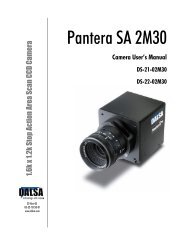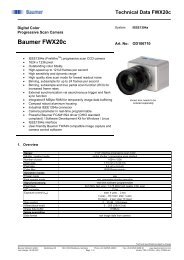Spyder 3 Camera User's Manual GigE Dual Line - Frame Grabbers
Spyder 3 Camera User's Manual GigE Dual Line - Frame Grabbers
Spyder 3 Camera User's Manual GigE Dual Line - Frame Grabbers
You also want an ePaper? Increase the reach of your titles
YUMPU automatically turns print PDFs into web optimized ePapers that Google loves.
66<br />
<strong>Spyder</strong> 3 <strong>GigE</strong> User <strong>Manual</strong><br />
A2.2 Analog and Digital Signal Processing Chain<br />
Processing Chain Overview and Description<br />
The following diagram shows a simplified block diagram of the camera’s analog and<br />
digital processing chain. The analog processing chain begins with an analog gain<br />
adjustment, followed by an analog offset adjustment. These adjustments are applied to<br />
the video analog signal prior to its digitization by an A/D converter.<br />
The digital processing chain contains the FPN correction, the PRNU correction, the<br />
background subtract, and the digital gain and offset. All of these elements are user<br />
programmable.<br />
Figure 24: Signal Processing Chain<br />
Analog Processing<br />
Digital Processing<br />
analog video<br />
digital video<br />
analog<br />
gain<br />
sag,ccg<br />
analog<br />
offset<br />
sao,cao<br />
PRNU background digital system<br />
coefficients subtract<br />
gain<br />
ccp,cpa ssb ssg<br />
FPN<br />
coefficients<br />
ccf<br />
digital<br />
offset<br />
sdo<br />
Analog Processing<br />
Optimizing offset performance and gain in the analog domain allows you to achieve a<br />
better signal-to-noise ratio and dynamic range than you would achieve by trying to<br />
optimize the offset in the digital domain. As a result, perform all analog adjustments<br />
prior to any digital adjustments.<br />
1. Analog gain (59Hsag or 60Hccg command) is multiplied by the analog signal to increase the<br />
signal strength before the A/D conversion. It is used to take advantage of the full<br />
dynamic range of the A/D converter. For example, in a low light situation the<br />
brightest part of the image may be consistently coming in at only 50% of the DN. An<br />
analog gain of 6 dB (2x) will ensure full use of the dynamic range of the A/D<br />
converter. Of course the noise is also increased.<br />
2. The analog offset (61Hsao or 62Hcao command) or black level is an “artificial” offset<br />
introduced into the video path to ensure that the A/D is functioning properly. The<br />
analog offset should be set so that it is at least 3 times the rms noise value at the<br />
current gain.<br />
Digital Processing<br />
03-032-10158-06 DALSA
















